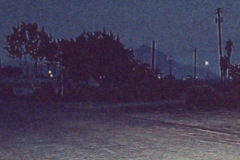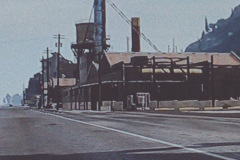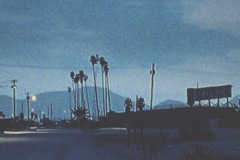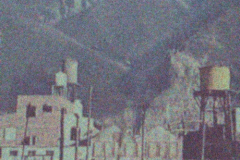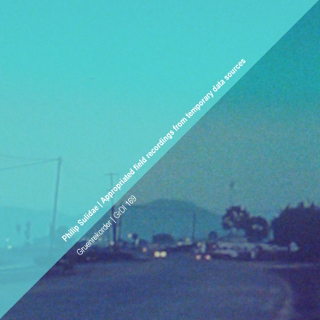
Appropriated field recordings from temporary data sources | Philip Sulidae
GrDl 169 | Gruen Digital > [order]
MP3 & FLAC
Reviews
I am a sound artist working predominantly with field recordings with an emphasis on post-processing, however recently I have become quite interested in open world video games and the extensive sonic environment that is built for them. Using procedural generation to create texture and form in game graphics is quite common, and I found the structure and dispersal of sounds used in open world games to follow a similar pattern. Pre-recorded blocks of specific sounds are algorithmically generated and distributed, although there is always a reference to specific location within the open world. The actual gameplay then dictates how and when these blocks of sound are used, creating a different sound experience every time you enter this environment. This is heightened by the ability to „roam“ throughout what are quite large and distinct worlds. I felt it possible to create sound works built around these generative sound environments. Following this, I approached the open world in a similar manner in which I approach field recording in „real“ environments. Basically, I listened and followed my ears.
I think it is also interesting to mention the topic of appropriation which will naturally arise in this kind of work. Of course there are elements of appropriation present in these pieces, but compared to the static nature of an artist such as Richard Prince, I feel these pieces are a substantial variation on that. In many ways field recording is the collation of data; if in an open world environment the data is procedurally generated, yet appears in a near arbitrary manner, then the collection of this data would nearly always be different. In layman’s terms, I would always end up with recordings of varying sets of sounds regardless of the fact I was in the same, contained environment with a finite set of sounds. In many ways this is closer to recording „real“ environments, than the appropriation of someone else’s invariable work.
This project also reflects my interests in the writings of Luis Borges and Jean Baudrillaud, whose ideas and thoughts on the notion of simulacra I find fascinating. The process of developing substitute or proxy sound environments that are perceived as real, yet simultaneously occupying a facade that is also inherently false presents another layer of meaning for the listener. Of course, these pieces still rely on the work of others, and they would not be possible without the brilliant work of the recordists, programmers and coders that create these remarkable environments. It is a testimony to their skills that it is possible to approach these locations in a „purist“ field recording mode and produce different, vivid results.
All recordings taken from journeys through open world gameplay, directly onto a Zoom H6 Recorder, with minor editing and equalisation in Protools. Due to the unknown quantity that is copyright law and litigation, I feel it is wise to refrain from mentioning which particular game I used. Let’s just say the title has an emphasis on the magnificent larceny of people movers. Images also taken from open world gameplay.
Track List
MP3
1 Meadows, flies, aeroplane and machinery
MP3
2 Peaks, flies, birds, radioactivity, trains and subterranean areas
3 Mountain streams, owls, coyotes and detonators
MP3
4 Meth lab, machinery, steps and outboards
5 Bouys and more flies
5 Tracks (41′33″)
Field Recording Series by Gruenrekorder
Gruenrekorder / Germany / 2017 / GrDl 169 / LC 09488
Review | By ATTN:Magazine
This one takes me back. I can remember my early experiences of navigating “open world” computer games back when they first started to emerge. I remember taking those nervous forays into vast, vibrant landscapes via Super Mario 64 and The Legend Of Zelda, unhooked from the rigid tracks of two-dimensional platform games, liberated from the ruthlessly imposed direction of travel and the requirement to roll monotonously from one objective to the next. Instead, I dithered and ambled. I stopped to examine the details and glitches of my digital scenery, or to analyse the repetitive back-and-forth movements of the game’s civilian furniture. Without the urgency of an objective to complete, open world gameplay offered the opportunity to break away and contemplate the meticulous artistry of computer game architecture.
What with me being about six years old, I wasn’t as enamoured by sound in the way that I am now. Otherwise I may have appreciated the ways in which open world gameplay placed new demands on the dynamic playback and stereo dispersal of sound in these sprawling universes, which were now required to respond to constant shifts in character orientation, proximity and physical interaction, dislodged from a sequence of events that was guaranteed by the restriction to left-to-right movement. Given that players construct their own narrative by moving through three-dimensional space, the soundscape is produced in real time as certain events emerge into audible range. Swarms of flies go from a peripheral buzz to a hostile high-voltage whirr, while the gurgle of the shoreline by my feet blurs into an undulation of white noise as I gradually move away from it. This isn’t simply a case of sounds becoming louder as the object becomes closer – with proximity comes the emergence of previously inaudible detail, shedding the obfuscation of echo to reveal the by-product of tiny flickers and miniature clicks. The sound itself changes form. From the perspective of a code-inept outsider, it all feels incredibly impressive.
On Appropriated Field Recordings From Temporary Data Sources, Philip Sulidae captures the sounds generated during a trawl through an unnamed open world computer game. His accompanying press release addresses the potential parallels between this record and the act of field recording in the real world, which is an important consideration. For one, it’s fascinating to consider the computer game experience as a field recording trip, listening acutely to the ensemble of noises that gather when the character is positioned at a particular point, while using the variable of character movement to produce a form of compositional structure, cross-fading the concrete patter of a leaking roof into the rumble of distant traffic by simply “walking” from one place to another. Essentially it’s a generative composition, reacting directly to the ever-changing behest of the player, inexhaustibly adjusting the listener’s acoustic framing to maintain a realistic sensation of immersion. Computer game soundscapes seem to be intentionally rendered as more bustling and restless than their real-world equivalents, exploiting the enveloping potential of sound to compensate for the unavoidable disconnection between the player and the televised image, doubling the protrusion of the heard in order to mask the distance between the seer and the seen.
Yet the decision to frame this album as field recording has an additional function. The sounds themselves are all the fruits of various sound recordists and editors, while the manner in which these sounds appear, combine and navigate the soundscape is all dictated by painstaking, intersecting streams of human-written computer code. In the real world, field recording captures an assemblage of noises, spaces and interactions that are (for the most part) devoid of one central point of instigation. Yet given the way in which the game code reacts so sensitively to player movement – producing innumerable possibilities for the order that the sounds appear and the ways in which they interrelate – can we really refer to the game designers as composers in this scenario, any more than we must offer artist credit to those captured in idle conversation via a public field recording in the real world? Sulidae seems wonderfully uncertain about this. The use of the word “appropriated” in the album title is both a means of capturing the ambiguity of ownership over these soundscapes, while also paying homage to the wonderful minds that orchestrated these rich, ever-shifting, three-dimensional depictions of industry, mountain fauna, public transport and idle pastoral sway. Field recording or not, it’s a beautiful form of duet.
link
Beach Sloth
Philip Sulidae opts for a surreal exploration of sound on the otherworldly presence of “Appropriated field recordings from temporary data sources”. Over the course of the album the way that Philip Sulidae lightly edits the world gives it a masterful, rich feeling. The attention to the smallest elements of sound, from meadows to machinery, ensures that he captures a wide swath of human experience. By taking on such an approach the sound teems with life, with some moments growing quite physical at times. Letting the beauty and ugliness of the world combine the album itself feels akin to a journey.
Setting the tone for the album is “Meadows, flies, aeroplane and machinery”. Gentle at first the song peaks in the middle only to delve into subdued industrial hums before simply drifting gingerly away. Eerie and by far the highlight of the album is the pulsating menace that is “Peaks, flies, birds, radioactivity, trains and subterranean areas”. Within this elongated piece, Philip Sulidae opts for a fully formed sound, one that incorporate the natural and the imposed. Kinder in tone “Mountain streams, owls, coyotes and detonators” chooses a meditative path. The layers of sound indicate a kind of thoughtfulness for the track, with only the last stretch devoted to human intervention. A full active sound dominates the kinetic work of “Meth lab, machinery, steps and outboards”. Ending the album off on a high note is the violent impact of “Bouys and more flies”. Nearly silent at first the sound works itself into a frenzy by the chaotic finale.
A celebration of the world’s quieter sounds, Philip Sulidae’s “Appropriated field recordings from temporary data sources” feels tactile and downright soothing.
link

